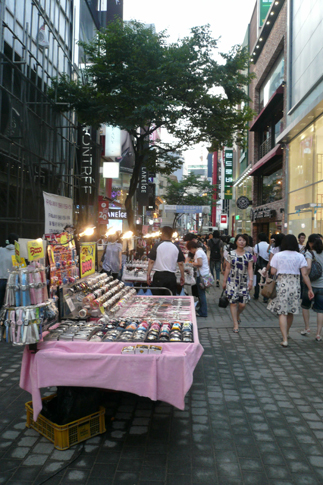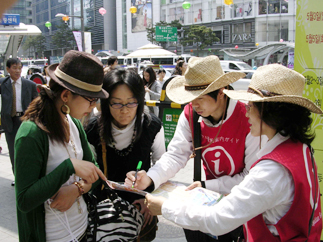A hip tourist hot spot in the thick of it all

The main street of Myeongdong with various street vendors. Provided by the SGC
N Seoul Tower? Nope. Deoksu Palace? Negative. Namdaemun market? Try again.
A recent survey conducted by Seoul city government found that the top spot for foreign tourists is none other than the bustling shopping area of Myeongdong.
Although it’s widely known locally as a financial district, Myeongdong in recent years has emerged as a capital of fashion, culture and shopping, packed with bustling streets, large department stores and malls, a cornucopia of restaurants and steaming street stalls. The area also is extremely easy to get to by bus, subway and on foot, and lodging possibilities are plentiful ? further enhancing its allure. The following is all you need to know about the area.

Guides dispatched by the Patrolling Tourist Information Service help foreign tourists.
Q. Are there any particular historical points of note in Myeongdong?
A. During the Joseon Dynasty, the area was the administrative capital of Seoul, which was called Hanseong at the time. “Myeong” means “brightness,” so the area’s name literally translates in English to “bright village.” Nowadays, the area is of course more simply known as a commercial, shopping and tourism center. Towards the end of the Japanese colonial period the adjacent district of Chungmuro developed into a business district, which rippled to Myeongdong as well. The area gradually transformed into a shopping district, and locals started tagging Myeongdong with new monikers such as “an avenue of art and romance” and “fashion’s No. 1 avenue.”
In 2000, the area was designated as a special tourism district. With hallyu, or the Korean wave, taking root in various countries abroad, the number of foreign tourists began to increase exponentially. In addition to large department stores such as Lotte and Shinsegae - where shoppers can easily find top Korean and international brands - Myeongdong also is home to numerous boutique stores featuring the latest in clothing, accessories, cosmetics and shoes.
Myeongdong is also in the heart of the city, located close to Seoul Station, Namdaemun and City Hall. To access the area by subway, get off at either Euljiro 1(il)-ga station (line No. 2) or Myeongdong station (line No. 4).
What are my options for sightseeing, eating and sleeping in the Myeongdong area?
The Myeongdong Theater was a bastion of Korean cultural arts until the mid-1970s and has been renovated several times since then. Take the subway to Euljiro 1(il)-ga Station and use exit 6. Another famous landmark in the area is Myeongdong Cathedral, the first Western-style brick building built in Korea. The cathedral was constructed in Neo-Renaissance style and features a 45-meter steeple. Mass is held in English at 9 a.m. every Sunday. You can reach the cathedral by getting off at Myeongdong Station and heading to exit 8.
In terms of eating, the streets of Myeongdong are lined with various pojangmacha, or food carts. Popular eateries in the area include Myeongdong Gyoja Kalguksu (serving hand-cut noodles of various varieties), Yuganae Dakgalbi (specializing in spicy stir fried chicken), Baekje Samgyetang (featuring whole-chicken soup) and Gogi Ssam (specializing in cold noodles and barbecued meat). Information on these restaurants and other attractions is available in a guidebook published by the Seoul Metropolitan Government. To get a free copy of the guidebook - which is printed in English, Chinese and Japanese - stop by the Seoul Global Center between 9 a.m. and 6 p.m. Monday through Friday. It’s also available at one of the various tourist information booths run by the city.
Places to stay in the area include the Myeongdong Guesthouse, Seoul Backpackers Hostel, Namsan Park Hotel and TBS Hotel. These places are all listed on Innostel, http://innostel.visitseoul.net, which offers information about inexpensive and quality accommodations for foreigners.
What other tourist sites are located around Myeongdong?
Namsangol Hanok Village, situated at the base of Namsan, consists of a traditional Korean garden and five traditional hanok, or traditional Korean houses. Visitors can also check out some Korean crafts, folk games and performances. At 2 p.m. every Saturday there’s a traditional Korean wedding performance. The village can be accessed via Chungmuro Station (lines No. 3 and 4).
N Seoul Tower, widely known as Namsan Tower, is the highest point in Seoul, offering up can grand views of the city. There’s also a digital observatory, a teddy bear museum, restaurants and a gift shop. Those who wish to visit can either walk up the mountain or take a cable car, which can be accessed from Myeongdong Station (exit 3). Once exiting, walk in the direction of the Pacific Hotel. It costs 7,500 won ($6.05) for a round-trip ticket. For more information on the tower, visit www.nseoultower.co.kr.
Also near Myeongdong is the Korea House, a perfect example of traditional Korean architecture. You can also enjoy a traditional Korean meal, known as hanjeongsik, along with musical and dance performances. For more information and to make reservations, visit http://www.koreahouse.or.kr.
Is there a place in Myeondong where I can get tourist and cultural information about the area?
The Seoul Center for Culture and Tourism, located on the fifth floor of the M Plaza building in the middle of Myeongdong, offers a whole host of tourism information in Korean, English, Chinese and Japanese. There is also storage space available as well as a cafe, an international ATM, a mobile phone recharger and free Internet access (computer and wireless network). The center operates year-round from 10 a.m. to 10:30 p.m. and can be reached at (02) 3789-7961/2/3.
If you have trouble finding it, you can always stop by one of the multiple tourist information booths in Myeongdong or take advantage of the new Patrolling Tourist Information Service, which features local guides wearing red smocks. They walk the streets of Myeongdong every day from 10:30 a.m. to 7:30 p.m. to help tourists.
By Ryu Myung-Soo Contributing writer [sooryu@i-net.or.kr]










with the Korea JoongAng Daily
To write comments, please log in to one of the accounts.
Standards Board Policy (0/250자)